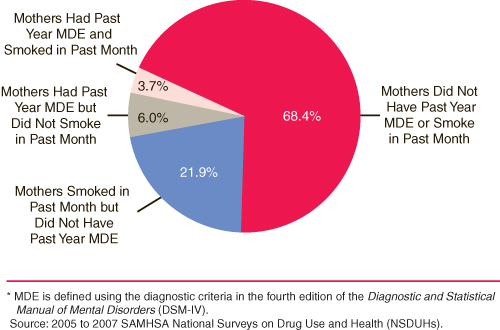
 |
| May 7, 2010 |
|
Of mothers living with adolescents, 1 in 10 (10.0 percent) had MDE in the past year, and 25.6 percent smoked cigarettes in the past month. The rate of past month smoking was higher among mothers with past year MDE than among those who did not have MDE (40.0 vs. 24.0 percent).
An annual average of 24.6 million adolescents lived with their mothers. Of these adolescents, 9.7 percent had mothers with past year MDE, and 25.6 percent had mothers who used cigarettes in the past month (Figure 1).
 |
| Mothers' Past Year MDE and Past Month Smoking |
Percent |
|---|---|
| Mothers Did Not Have Past Year MDE or Smoke in Past Month |
68.4% |
| Mothers Smoked in Past Month but Did Not Have Past Year MDE |
21.9% |
| Mothers Had Past Year MDE but Did Not Smoke in Past Month |
6.0% |
| Mothers Had Past Year MDE and Smoked in Past Month |
3.7% |
|
* MDE is defined using the diagnostic criteria in the fourth edition of the Diagnostic and Statistical Manual of Mental Disorders (DSM-IV). Source: 2005 to 2007 SAMHSA National Surveys on Drug Use and Health (NSDUHs). |
More detailed analysis showed that 21.9 percent of these adolescents lived with mothers who smoked in the past month but did not have past year MDE, 6.0 percent lived with mothers who had past year MDE but did not smoke in the past month, and 3.7 percent lived with mothers who both smoked in the past month and had past year MDE.
Although adolescents may initiate and sustain cigarette use regardless of their mothers' characteristics and behavior, rates of adolescent smoking were higher in the presence of each of the two maternal risk factors examined here. The rates of past month cigarette smoking were 14.3 percent among adolescents living with mothers who had past year MDE and 7.9 percent among adolescents living with mothers who did not have MDE (Figure 2). The rate of past month smoking among adolescents also was higher for those whose mothers smoked in the past month than for those whose mothers who did not smoke (16.9 vs. 5.8 percent).
 |
| Mothers' Past Year MDE and Past Month Smoking |
Percent |
|---|---|
| Mothers Had Past Year MDE | 14.3% |
| Mothers Did Not Have Past Year MDE | 7.9% |
| Mothers Smoked in Past Month | 16.9% |
| Mothers Did Not Smoke in Past Month | 5.8% |
|
* MDE is defined using the diagnostic criteria in the fourth edition of the Diagnostic and Statistical Manual of Mental Disorders (DSM-IV). Source: 2005 to 2007 SAMHSA National Surveys on Drug Use and Health (NSDUHs). |
Considering these two factors together, the rate of adolescent smoking was 25.3 percent for adolescents exposed to both maternal MDE and maternal smoking (Table 1). This was more than 4 times the rate for adolescents whose mothers neither smoked nor had a past year MDE (5.6 percent). Smoking rates were 8.1 percent for adolescents whose mothers had MDE but did not smoke and 15.5 percent for adolescents whose mothers smoked but did not have MDE.6
| Mothers' Past Year MDE and Past Month Smoking |
Number of Adolescents Reporting Past Month Smoking |
Percentage of Adolescents Reporting Past Month Smoking (Standard Error) |
|---|---|---|
| Mothers Did Not Have Past Year MDE and Did Not Smoke in the Past Month |
937,000 | 5.6% (0.56) |
| Mothers Had Past Year MDE but Did Not Smoke in the Past Month |
127,000 | 8.1% (1.62) |
| Mothers Did Not Have Past Year MDE but Smoked in the Past Month |
790,000 | 15.5% (1.59) |
| Mothers Had Past Year MDE and Smoked in the Past Month |
224,000 | 25.3% (5.04) |
|
* MDE is defined using the diagnostic criteria in the fourth edition of the Diagnostic and Statistical Manual of Mental Disorders (DSM-IV). Source: 2005 to 2007 SAMHSA National Surveys on Drug Use and Health (NSDUHs). |
This analysis has important implications both for parents and for health professionals. Clearly, in the home setting, exposure to parental smoking presents not only the risks attendant to secondhand smoke, but also the risk of adolescent modeling of the smoking behavior. Similarly, health professionals engaged in smoking-cessation interventions or in treating depression in women may wish to inform their patients of the increased risk of smoking for their children.
|
The National Survey on Drug Use and Health (NSDUH) is an annual survey sponsored by the Substance Abuse and Mental Health Services Administration (SAMHSA). The 2005 to 2007 combined data are based on information obtained from 7,359 mother-child pairs. The survey collects data by administering questionnaires to a representative sample of the population through face-to-face interviews at their place of residence. The NSDUH Report is prepared by the Office of Applied Studies (OAS), SAMHSA, and by RTI International in Research Triangle Park, North Carolina. (RTI International is a trade name of Research Triangle Institute.) Information on the most recent NSDUH is available in the following publication: Office of Applied Studies. (2009). Results from the 2008 National Survey on Drug Use and Health: National findings (DHHS Publication No. SMA 09-4434, NSDUH Series H-36). Rockville, MD: Substance Abuse and Mental Health Services Administration. Also available online: http://oas.samhsa.gov. |
| The NSDUH Report is published periodically by the Office of Applied Studies, Substance Abuse and Mental Health Services Administration (SAMHSA). All material appearing in this report is in the public domain and may be reproduced or copied without permission from SAMHSA. Additional copies of this report or other reports from the Office of Applied Studies are available online: http://oas.samhsa.gov. Citation of the source is appreciated. For questions about this report, please e-mail: shortreports@samhsa.hhs.gov.
NSDUH_166 |
This page was last updated on September 29, 2009. |